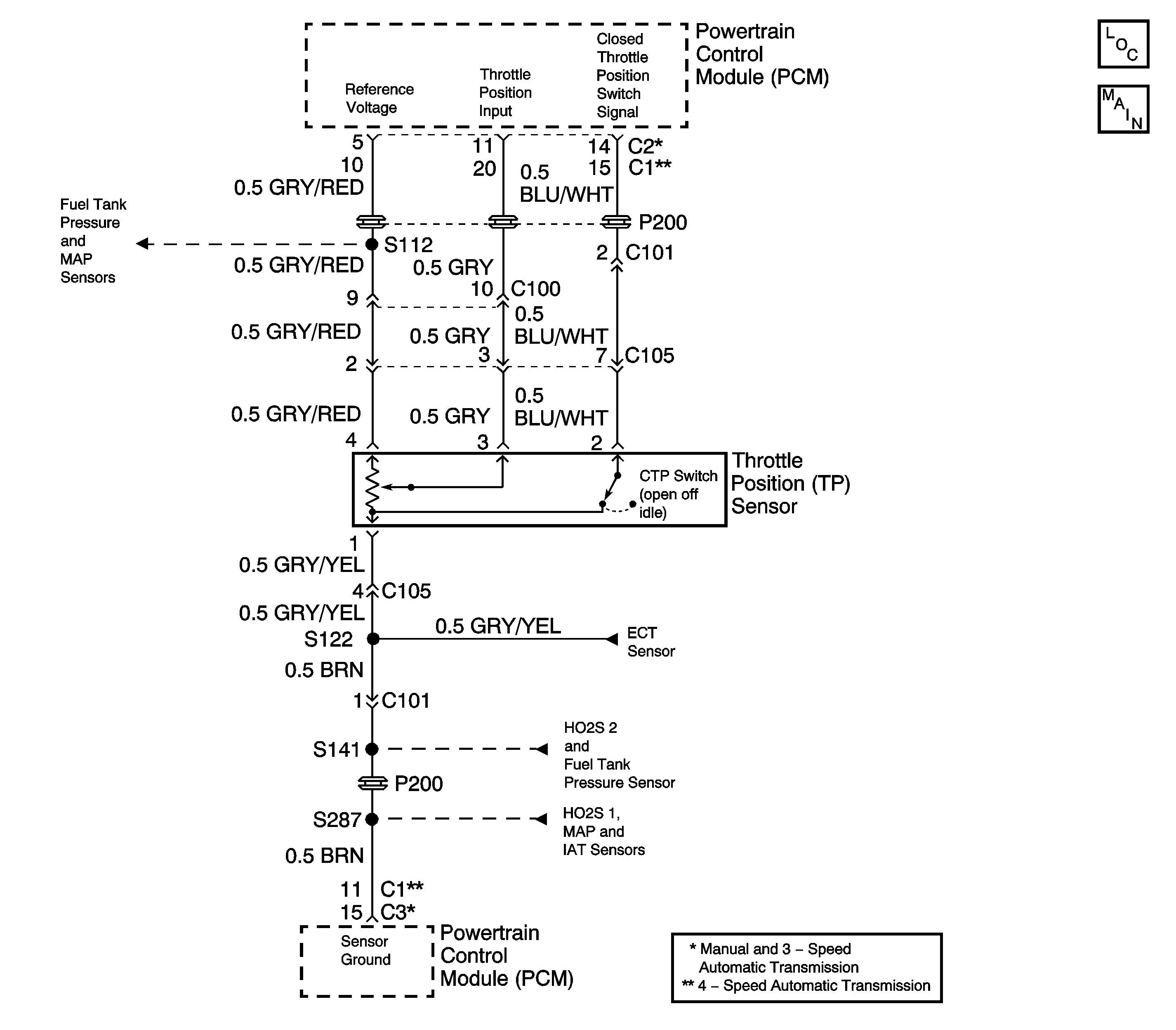
Circuit Description
The throttle position (TP) sensor contains a potentiometer whose resistance value changes along with the throttle valve position. The powertrain control module (PCM) provides a 5 volt reference voltage to the TP sensor. The PCM reads the voltage across the TP sensor and converts it into the throttle position. The TP sensor resistance decreases as the throttle valve opening increases. When the TP sensor resistance decreases the voltage being monitored at the PCM will increase. And when the TP sensor resistance increases, because the throttle valve opening is decreasing, the voltage being monitored at the PCM will decrease.
Conditions for Setting the DTC
| • | The ignition switch is ON. |
| • | Low voltage input at the PCM indicated. |
| • | Above condition is met for at least 5 seconds. |
Action Taken When the DTC Sets
| • | The PCM illuminates the malfunction indicator lamp (MIL). |
| • | The PCM records the operating conditions at the time the diagnostic fails. This information is stored in the Freeze Frame buffer. |
Conditions for Clearing the MIL/DTC
| • | The MIL turns OFF after three consecutively passing trips without a fault present. |
| • | A History DTC clears after 40 consecutive warm-up cycles without a fault. |
| • | Use the scan tool Clear DTC Information function or disconnect the PCM battery feed in order to clear the DTC. |
Diagnostic Aids
A misadjusted TP sensor could cause the malfunction to set. Refer to Throttle Position Sensor Adjustment .
An intermittent malfunction may be caused by a fault in the TP sensor electrical circuit. Inspect the wiring harness and components for any of the following conditions:
| • | Backed out terminals. |
| • | Improper mating of terminals. |
| • | Broken electrical connector locks. |
| • | Improperly formed or damaged terminals. |
| • | Faulty terminal to wire connections. |
| • | Physical damage to the wiring harness. |
| • | A broken wire inside the insulation. |
| • | Corrosion of electrical connections, splices, or terminals. |
If the DTC P0122 cannot be duplicated, the information included in the Freeze Frame data can be useful in determining vehicle operating conditions when the DTC was first set.
Test Description
Number(s) below refer to the step number(s) on the Diagnostic Table.
-
The OBD System Check prompts the technician to complete some basic checks and store the freeze frame data on the scan tool if applicable. This creates an electronic copy of the data taken when the fault occurred. The information is then stored in the scan tool for later reference.
-
This step determines if DTC P0122 is the result of a hard failure or an intermittent condition.
-
When the 5 volt reference is jumpered to the TP input circuit, the scan tool parameter should read 99%.
-
When the TP sensor input circuit is jumpered to battery voltage , the scan tool parameter should read 99%.
Step | Action | Value(s) | Yes | No |
|---|---|---|---|---|
1 | Did you perform the Powertrain On-Board Diagnostic (OBD) System Check? | -- | ||
2 |
Does the TP sensor percentage steadily increase within the specified range? | 0 to 94% | ||
3 |
Is a DTC P0122 set? | Refer to Diagnostic Aids | ||
4 |
Is the TP sensor percentage greater than the specified value? | 90% | ||
5 |
Is TP sensor percentage greater than the specified value? | 90% | ||
6 |
Was a repair necessary? | -- | ||
7 |
Was a repair necessary? | -- | ||
8 |
Was a repair necessary? | -- | ||
9 | Check the TP sensor input circuit for a poor connection at the PCM. Was a repair necessary? | -- | ||
10 | Check TP signal and 5 volt reference circuits for a poor connection at the TP sensor and PCM. Repair the terminals as necessary. Was a repair necessary? | -- | ||
11 |
Was a an adjustment necessary? | -- | ||
12 | Replace the TP sensor. Refer to Throttle Position Sensor Replacement Is the action complete? | -- | -- | |
13 | Replace the PCM. Refer to Powertrain Control Module Replacement Is the action complete? | -- | -- | |
14 |
Are any DTCs displayed on the scan tool? | -- | Go to the applicable DTC Table | System OK |
